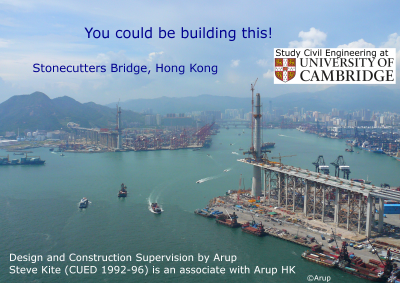
| Engineering Department > Structures Group |
This document contains links to details of the current courses; they are liable to change from year to year. A few of the links may not be accessed from outside CUED .
So you want to become a Civil Engineer, but Cambridge doesn't offer a Civil Engineering course? Although we don't offer a specific course entitled Civil Engineering, the general course is designed so that our graduates can go on to specialize in many disciplines, one of which is Civil Engineering. This web page gives details of the sort of route you will follow if you intend to go on to follow that career.
For information about how to apply to Cambridge, go to the Undergraduate Admissions page.
All routes through the Cambridge Engineering course have been approved by the Institution of Civil Engineers and the Institution of Structural Engineers as providing exemption from the academic part of their requirements for Corporate Membership.
The illustrations on this page show some of the work being undertaken by recent graduates from the Civil Engineering courses at Cambridge University. They show some of the things you could get involved in. Each image is available as a pdf file that can be printed and displayed in careers rooms in schools but the files are quite large so that good quality images can be displayed.
The first two years are common to all engineering students, but in the third year you will have to choose to be assigned to a "Subject Area "; one of these is Civil Engineering. It is only at this stage that you have to choose which courses to take, by which time you will have gained some experience of what each of the subjects entails. Even if you expressed an opinion at the time of your admissions interview about what you intended to study, no one will worry if you have changed your mind.
So what courses will you take and how relevant are they to Civil Engineering?
All students take the same Courses in the first year, many of which would be taken in specialized Civils courses elsewhere. These include Structures, Kinematics, Mathematics, Dimensional Analysis, Computing, Mechanical vibrations, Materials and Engineer in Society . The Fluid Mechanics part of the Thermofluids course would also appear in any Civil Engineering course. There is also a Structural Design Course, in which you will design, build and test to destruction a framed structure, and an Exposition class, which is aimed at making engineers better able to express themselves. The only courses that you will take that are not in specialist Civils courses are Electricity and Thermodynamics.
The Emirates Stadium for Arsenal Football Club was designed by Paul Westbury of Buro Happold, who graduated from Cambridge in 1991. Click the image to download a copy as a poster (12 MB). |
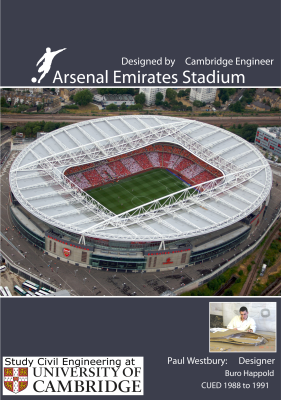 |
The second year courses are also taken by all students, with the exception of the options course in the third term. All of these subjects are examined. Once again, many of these courses would be found in conventional Civils courses. These include Mechanics, Structures, Materials, Fluid Mechanics, Vector Calculus, Linear Algebra and Probability.
In the third term there are eight options courses. These are designed to give you a taste of the different disciplines so that you can make a sensible decision about your career. They are timetabled so that you can go to the lectures for as many courses as you wish, but in the examination paper for the options courses you will have to answer questions on two of the subject areas only. You can also take a foreign language in place of one of your options.
The Civils options course takes the title Creating Underground Space. It is designed to give you an introduction to the important subjects of Soil Mechanics and Reinforced Concrete, and shows how these relate to real world problems, such as designing tube tunnels or creating underground car parks.
It is not compulsory that you take the Civils option in the second year even if you want to go on to do Civils papers later.
At the beginning of this year you must decide which subject area you will belong to and you then have to take six modules (out of ten) from that subject area. The Civils papers are put together in Group D and it is assumed below that this is the option you have chosen.
The third year papers are arranged as a series of 16 lecture modules: Geotechnical Engineering (3D1, 3D2), Structures (3D3 and 3D4) Environmental Engineering (3D5 and 3D6) and Mechanics of Solids (3C7 and 3D7). Many of the modules offered by the Mechanics Group and the Management Group are also relevant to Civil Engineering.
You will also undertake a "Engineering Area Activity". For civil engineers, this takes the form of a Surveying Course, usually undertaken at the beginning or end of the Easter vacation. There are a number of other surveying courses which are outlined in a flowchart .
The third year examinations are taken immediately after the Easter vacation. You then spend the rest of the term doing two projects; one option is to spend a week taking the Constructionarium.
At the end of your third year, you can leave Cambridge with a BA degree, but if you do so you will not have satisfied the Institutions' requirements, and you will not be able to go on to become a professional engineer without taking further courses elsewhere. Virtually all students stay on to take the fourth year courses.
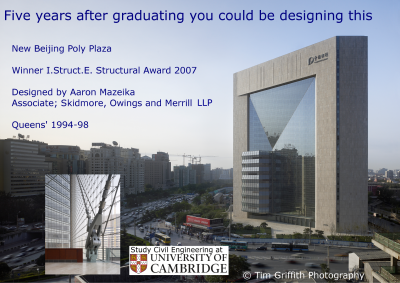 |
Two structures designed by Aaron Mazeika, an Associate with Skidmore, Owings & Merrill LLP, who graduated ffrom Queens' College in 1998. Click images to download posters (left, 16 MB; right 11 MB) |
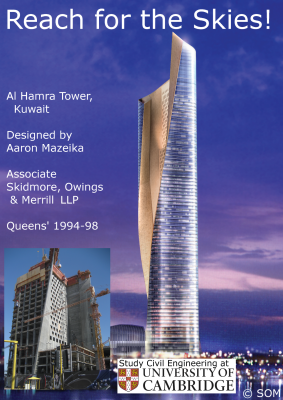 |
The fourth year is arranged as a set of modular courses, and a project. You have to take eight modules, at least 4 of which must come from the nine modules offered in Civil Engineering. These may change from year to year, but the Civils modules currently on offer are listed, as is the surveying module.
Many of the modules offered in other courses are of interest to Civil Engineers, especially those offered by the Mechanics Group.
The project will usually be taken in your chosen professional discipline, and they are often very specialized and taken by one student only. They frequently involve original research and thus change each year. Students are expected to spend about half of their time working on their project.
At the end of the fourth year you will graduate with an M.Eng. degree. You will be exempted from the examination requirements of the I.C.E. and the I.Struct.E., in exactly the same way as if you had taken a specialized Civil Engineering course. But you will also have learnt the basics of Electrical, Mechanical and Aeronautical Engineering, as well as Fluid Mechanics, Thermodynamics and Materials Science.
The aim of the course is to produce graduates who have a sound understanding of the theoretical principles which underlie Civil Engineering, and at least a basic knowledge of other engineering disciplines. We believe that our undergraduates are bright enough to take in this broad level of detail, and that the college supervision system ensures that you will leave with a sound understanding of the courses you have taken.
We teach design in our courses, but not to the level of detail where you learn the specific clauses in the current British Standards or the Eurocodes. Those clauses will change in future years, and many of you will work in industries where different sets of standard are used. But if you understand the principles, you will be able to make sense of the standards yourself later; we hope that your course will remain relevant to you years after you have left Cambridge.
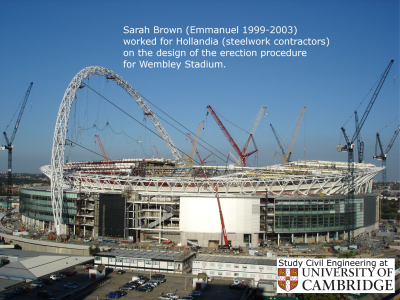 |
| Sarah Brown (Emmanuel 1999-2003) worked for Hollandia, the Steelwork Contractors, on the erection sequence for the roof of Wembley Stadium. Download poster (9MB). |
After you graduate with your M.Eng. degree you will find yourself in demand by Civil Engineering employers. One of the biggest grumbles we face from employers is that we simply don't produce enough Civil Engineering Graduates. So except in times of the deepest recession, our graduates normally have a choice of several job offers.
To complete your professional training you should become a Chartered Member of one of the Professional Institutions. This would normally be either the Institution of Civil Engineers, which covers the broad range of the discipline, or the smaller but more specialized Institution of Structural Engineers. There are also a range of other specialist institutions.
The normal route to Chartered status is exactly the same for Cambridge graduates with their general degree as it is for graduates with specialist Civil Engineering degrees. It involves a period working in industry, often taking part in a scheme whereby your employer gives you a wide range of experience of design, construction and commercial aspects of engineering. This usually lasts three or four years after graduation, and is often followed by an examination and/or interview by senior members of the profession.
When you have passed that hurdle you can call yourself a Chartered Engineer. Your formal education is complete and you can take professional responsibility for the work you do. But there will always be new things to learn; new techniques; new materials, and new problems to apply them to. Your general Cambridge engineering background should continue to be of use to you.
Some teaching materials for use in schools for the final year of GCSE have been prepared by CUED Engineering Students as part of their 4th year projects. These are available for free download and have been designed to complement the Maths, Physics and DT syllabuses, with a view to showing how these subjects relate to the real world and to encourage the students to take Physics at A level.